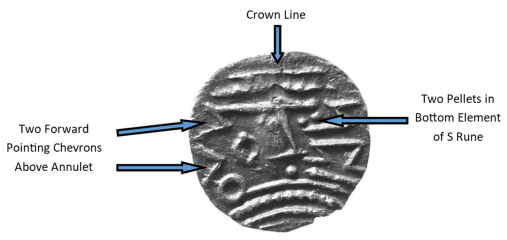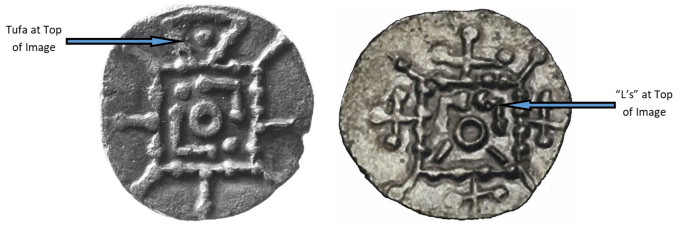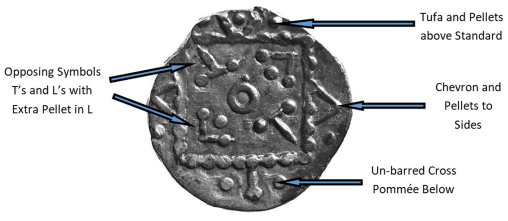Introduction to R9 Sceatta Type Classification
Research into the criteria to determine the classification of a type R9 Sceat.
To determine the iconography required for classification of a Sceat as an R9 coin, I have examined the criteria listed in a number of texts, see below.
Metcalf (T & S vol 3 1994 p517) describes his criteria for classifying a coin as an R9. He focuses his attention on the use of the runes SPI and EPA on the obverse. The inclusion of a Tufa in the design on the reverse and the “ornaments of the reverse border” and the use of chevrons is also discussed. One coin is shown that does not have a Tufa on the reverse but the “R8” style of four crosses pommée, one to each side of the standard. The two examples shown have different symbols within the standard, the one with the Tufa above has opposing T’s and triangles of pellets, the other has the more “R8” style of symbols of L’s and angled lines. The coin with a Tufa has the runes SPI and the one with four crosses, the runes EPA. Coin shown Plate 25/421. Metcalf also mentions a stylistic link between R5 and R9 coins pp517-518.
Gannon (Sylloge of Coins of the British Isles 63 2013 plate 29 684 to 687) gives the rather brief description of “Group R9 Blackburn H Obverse: bust with no neck; rune inscription spi/epi. Reverse: variety of standards.” The coin descriptions record the runes as SPI, EPA and SEW.
Abramson (Sceatta List 2012 p67) catalogues the R9 as… “Degenerate, angular radiate bust left, crescent ear, protruding lips, runic legend SPI inverted before, > and annulet behind, two curved exergual lines either side of beaded line. Beaded degenerate standard containing opposing geometrical symbols, tufa above, lines to other sides, diagonals at outer corners.”. He also indicates that there is no beaded border on either obverse or reverse of the coin. Abramson allocates the type/class number of S/1/11/140.
As mentioned above by Metcalf he considers there to be two combinations of runes used on the obverse of the flans in front of the bust. These are SPI and EPA. Abramson lists only one, SPI, in Sceatta List. Gannon in “Sylloge 63 British Museum” describes three, SPI, EPA and SEW. I have noticed this combination also on coin ID 02 (Abramson Collection). Are these runes read SEW or WES?
The Early Medieval Corpus (EMC) database doesn’t appear to provide any written rationale or explanation for including Sceatta into a particular R Type.
R I Page in (An Introduction to English Runes p41) describes how runes are written in a variety of ways. This can be lines of text from left to right or vice versa, individual words or individual letters back to front or even upside down.
I have examined a number of coins on the EMC database at the Fitzwilliam Museum Cambridge and included 9 of them in the research, one of them being in my collection. One coin from my collection without a find spot. Five coins from the Abramson Collection and four from the British Museum shown in Gannon’s “Sylloge 63”. The one coin pictured in T & S Plate 25/421 as an R9 is also registered as EMC 1993.9421.
Elements of Iconography Featuring in the Research
As with other research into the R series Sceatta I have used the Runes on the obverse of the flan as a main feature in determining the classification of coin types. The Tufa on the reverse has also been used a main consideration. Other aspects of the iconography used include the symbols behind the head on the obverse and the symbols both inside and outside of the standard on the reverse.
All of the coins had a right facing head with exergual lines below it on the obverse. Every coin had a central annulet within the standard on the reverse. Apart from coins ID 1 and ID 19 all others had 45° angled lines pointing outwards from the four corners of the standard.
Runes
There were two main combinations of runes used on the coins researched. Nine coins had the runes SPI and seven having EPA. On one coin, ID 17, the runes could not be seen clearly enough to positively identify them. Two coins, ID 2 and ID 9 have the unusual rune “W”, my thanks to Dr Oliver Padel for identifying the “W” rune on coin ID 2. Coins ID 1 and ID 19 had a large pellet above the “E” rune.
All coins with the runes SPI were written in a clockwise format reading from the top downwards. Only one coin with the runes EPA (ID 5) had them written in an anti-clockwise manner. Six of the SPI coins had pellets within the bottom element of the S rune. Both of the coins with the runes WEA had the runes written in an anti-clockwise fashion.

Symbols behind the head
All coins had a least one chevron that was pointing towards the back of the right facing head. With the exception of ID 1 and ID 19 all coins had at least one annulet behind the head. The most frequently occurring combination was two forward pointing chevrons above an annulet. Although not behind the head, one coin had a triangle of pellets below and to the front of the head which looks very much as though they were meant to represent a beard.
Crown
Nine of the coins had a crown above the head, eight of these were a three point crown, the remaining one had a two point crown. One coin, ID 2 had what looked like a three point crown which consisted of three X’s. On coins ID 11 and ID 16 it was not possible to positively identify the crown. Eight coins had what I have called a “crown line” only.
Exergual Lines
Most coins have three exergual lines. Often the middle line is beaded. All coins have curved exergual lines, the degree of curve varies considerably.

Tufa
I have shown all images of the reverse of the coins with the Tufa (when there was one) at the “Top” of the image. Twelve of the coins had a Tufa to the top of the standard on the reverse. Seven coins did not have a Tufa, all of these seven coins had a cross pommée to each of the four sides of the standard. With coins showing two “L’s” and two “/’s” around the central annulet I have shown the image with the “L’s” at the top. Some crosses were unbarred, some barred.

Symbols within Standard
There were “T’s” or “L’s” inside the standard on the reverse. These were sometimes adjacent (image above right) and sometimes opposing (image above left). Some also contained single pellets or triangles of pellets. The coins with a Tufa had opposing similar symbols and those without a Tufa had adjacent similar symbols. All coins had a central annulet. No coins with a central pellet were seen in the R9 group.
Chevrons to Sides
Two coins (which are a possible die match) had a chevron and pellets to each side. They also had a Tufa above the standard and also unusually pellets to either side of the Tufa. There was an unbarred cross below the standard.

Cross Pommée
All of the coins without a Tufa above the standard on the reverse had a cross pommée to each of the four sides of the standard. All of the coins with four crosses outside of the standard had two “L’s” and two “/’s” around the central annulet inside the standard.





